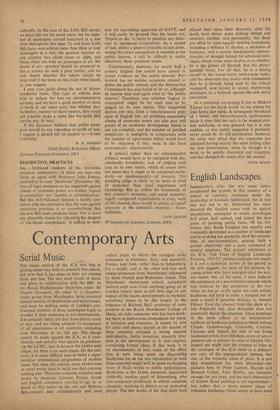English Landscapes
IMMEDIATELY after the war some critics prophesied the growth in this country of a school of romantic, landscape under the leadership of Graham Sutherland, but in fact this was not to be, Sutherland has. since deserted the English scene with its special associations, attempted to create personages half plant, half animal, and joined the skin game of painting public faces. Of his fol- lowers, only Keith Vaughan has steadily and constantly developed as a painter of landscape and in so doing has gradually shed the manner- isms of neo-romanticism, gaining both a greater objectivity and a surer command of natural structure. The present exhibition at the ICA, 'Ten Years of English Landscape Painting, 1945-55; perhaps attempts too much; it is not a historical survey of the period as the title suggests, for most of the pictures, by young artists who have emerged since the war, are recent; but, all the same, it does indicate the conclusion of a neo-romantic episode which was fostered by the conditions of the war when we fed so avidly upon our own artistic traditions and tried to make a banquet out of such a small if precious delicacy as Samuel Palmer. Even the absence from this show of a late Palmerite like Alan Reynolds does not essentially distort the situation. These paintings in the main adhere to an international tradition of landscape painting to which belong Claude, Gainsborough, Constable, Courbet, Cezanne and, indeed, the best of our living landscape artists, (von Hitchens, seven of whose pictures can at present be seen at Gimpel Fils. Indeed one might take the absence of titles in the catalogue of the ICA show as a defiance not only of the topographical interest, but also of the romantic senso of place. It is not that romanticism has been discarded—the pictures here by Peter Lanyon, Harold and Bernard Cohen, John Bratby, are romantic enough for any taste, and the cool observation of Euston Road painting is not represented— but rather that a more mature phase of romantic landscape vision seems to have been
reached in much the same way that the later pictures of Turner or the best Constables represent a movement on from the picturesque romanticism of other or curlier artists. The diversity of work on view is very marked and includes excellent pictures by Lanyon, Patrick Heron, Martin Froy, Anthony Fry, Edward Middleditch, Philip Sutton, but as Andrew Forge says in his introduction to the catalogue, 'the operative motive in their work is not to do with an idea of nature with a capital "N" so much as with their own response to their surroundings.' The avoidance of a literary allusiveness and the absence of a picturesque version of paintable subjects are indeed most



































 Previous page
Previous page